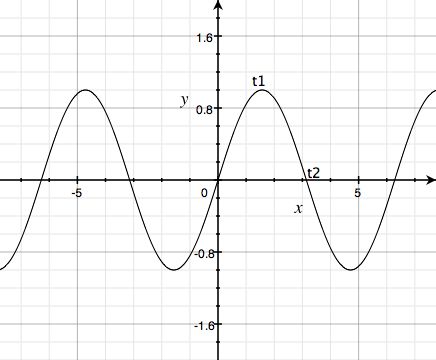When you shop for a head unit, the line voltage for the RCA jacks on the back of the radio are often advertised as being 2 volts, or 4 volts, or with some models such as Eclipse, as high as 8 or 16 volts. What does this all mean? Is more always better? What is the best voltage for your amplifiers? Will a higher line voltage mean a louder stereo system? Let's try to answer some of these questions, and by doing so, bring about a better understanding of what some of these marketing catch-phrases really mean to you.

First, I'd like to explain exactly what the line voltage is. The audio signal put out by your head unit to the amplifier(s) is an AC (alternating current) signal, like the one above, where the X axis represents the audio frequency being transmitted, and the Y axis represents the amplitude, or volume of the signal being sent.
The Y axis is measured in Volts (2 volts in each direction for a head unit that's advertised as a "4 volt pre-out" model) while the X axis, or frequency is measured in Hertz (Hz) or Kilohertz (KHz.)
The input stage of your amplifier has a gain setting, or input sensitivity knob which allows the installer to tune the input stage of the amplifier to match the voltage put out by the head unit. More about that is explained Here.
If the signal represented above includes a bit of noise introduced in the recording studio for the CD you're playing, or from the quiet hiss you often hear in some cars where the volume of the radio is turned up, but no audio signal is being played (between CD tracks for instance) then the more voltage you have at the line level (4 volts instead of 2 volts for example) on the Y axis, then the lower that amount of noise is going to be. This is called the "noise floor" and the higher your line voltage, the lower that noise floor will be. This is also represented as your "signal to noise ratio." With more voltage, the S/N ratio is higher, meaning more signal, less noise.
The other advantage to having a higher line voltage from your pre-outs is a higher resolution signal. The more amplitude (Y axis) you have in your source signal, the more detail you'll be able to squeeze into that waveform. Think of it like zooming in on a JPG image. If the original image is high resolution to start with, then when you expand the image to a larger size (as the amplifier does with the audio signal) then your resulting, larger image will be sharper, whereas if the original image is a low resolution thumbnail type image, then when it's enlarged, the image will not be as clear or detailed.
Now, the one thing to be aware of when looking at the line voltage of a head unit, is that most amplifiers made today have a limited range of input voltages that they are designed to accept, and the maximum line voltage for most amplifiers is in the 4 to 6 volt range. If you get a head unit with an 8 volt pre-out, and your amplifier only accepts a maximum line input voltage of 4 volts, then you can over-drive the input stage of the amplifier, and cause the amp to enter clipping. The way to avoid this is to do your research before purchasing your components for your audio system. If you do however, find yourself in this predicament, you can fix the problem by using an oscilloscope and a digital multimeter to observe the output voltage with a white or pink noise test tone at a 0dB reference output, and turn the head unit volume up until you see a clean 4 volt output. This is the volume you must not surpass to prevent clipping the signal at the amplifier. The use of a pre-amp with a volume control is one way to leave the head unit's volume control set to the required volume position, while allowing you full analog control over volume for the system.
Here's a picture of some RCA line-level pre-outs on a modern Alpine head unit.


